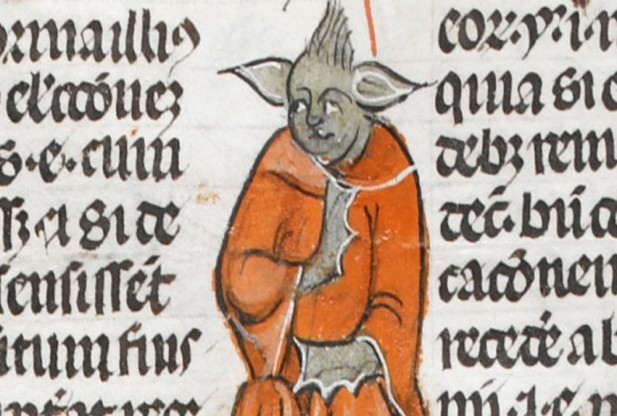
© British Library
In most versions of the Biblical story of Sampson, the ancient Israelite gained incredible strength through his hair, but if a 14th century image currently making the rounds on the Web is accurate, he might have also had some help from a certain Jedi master.
It's hard to deny that this illustration of a monk bears a striking resemblance to the popular
Star Wars character Yoda, as
Mashable pointed out on Thursday. Yoda was spotted in the Decretals of Gregory IX with gloss of Bernard of Parma (also known as the
Smithfield Decretals) by historian Damien Kempf while he was researching for his book
Medieval Monsters.
According to the website, Kempf said during a recent interview that he "actually couldn't believe it" when he spotted the Yoda-like monk in a 700-year-old manuscript. Julian Harrison, curator of pre-1600 historical manuscripts at the British Library, told
NPR that the artist who illustrated the manuscript "clearly had a vivid imagination."

© Lucasfilm/Disney
NPR went on to explain that the Smithfield Decretals were created in southern France between 1300 and 1340, and were a collection of papal letters combining doctrine and decrees on church law.
The image was also highlighted recently, along with several other odd images, by historians Damien Kempf and Maria L. Gilbert on the Library's
Medieval Manuscripts blog.
Among the other creatures featured in pictures on the blog were a big-eared race known at the Panotii that somewhat resemble the Ferengi race from
Star Trek, a half-woman, half-bird hybrid, and an apocalyptic beast with six heads and ten horns. The Library started posting these pictures on the Internet back in 2010, Harrison said in an interview with
The Guardian.When the blog was first launched, he said it was "a niche thing for a niche audience," but now, the Library uses it "to promote what we do. One popular post explains why we don't wear white gloves to handle manuscripts, but we also try to cater for a non-academic readership."
"Our most popular post is Knight v. Snail that looks at why images of armed knights fighting snails are common in illuminated manuscripts," Harrison continued, adding that the blog now has "an incredibly international readership," and draws more than 36,000 readers per day. Not bad, when you consider they started off with a modest two visitors per day, but not surprising.
After all, who can pass up a blog that features Yoda in a 14th century manuscript? Not us!
All this article does is support the idea that Americans can't stomach anything unless it can be pre-digested into crap American sci-fi bubblegum, and that Americans are very very far from normal.